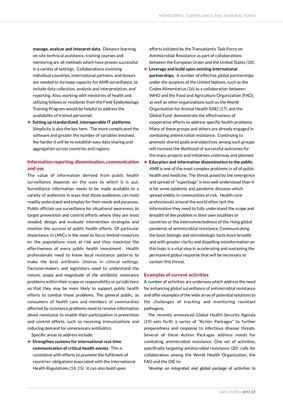
manage, analyze and interpret data. Distance learning,
on-site technical assistance, training courses and
mentoring are all methods which have proven successful
in a variety of settings. Collaborations involving
individual countries, international partners, and donors
are needed to increase capacity for AMR surveillance, to
include data collection, analysis and interpretation, and
reporting. Also, working with ministries of health and
utilizing fellows or residents from the Field Epidemiology
Training Program would be helpful to address the
availability of trained personnel.
‰ Setting up standardized, interoperable IT platforms.
Simplicity is also the key here. The more complicated the
software and greater the number of variables involved,
the harder it will be to establish easy data sharing and
aggregation across countries and regions.
Information reporting, dissemination, communication
and use
The value of information derived from public health
surveillance depends on the uses to which it is put.
Surveillance information needs to be made available to a
variety of audiences in ways that those audiences can most
readily understand and employ for their needs and purposes.
Public officials use surveillance for situational awareness, to
target prevention and control efforts where they are most
needed, design and evaluate intervention strategies and
monitor the success of public health efforts. Of particular
importance in LMICs is the need to focus limited resources
on the populations most at risk and thus maximize the
effectiveness of every public health investment. Health
professionals need to know local resistance patterns to
make the best antibiotic choices in clinical settings.
Decision-makers and legislators need to understand the
nature, scope and magnitude of the antibiotic resistance
problems within their scope or responsibility or jurisdictions
so that they may be more likely to support public health
efforts to combat those problems. The general public, as
consumers of health care and members of communities
affected by resistance problems need to receive information
about resistance to enable their participation in prevention
and control efforts, such as receiving immunizations and
reducing demand for unnecessary antibiotics.
Specific areas to address include:
‰ Strengthen systems for international real-time
communication of critical health events. This is
consistent with efforts to promote the fulfilment of
countries' obligations associated with the International
Health Regulations (14, 15). It can also build upon
efforts initiated by the Transatlantic Task Force on
Antimicrobial Resistance as part of collaborations
between the European Union and the United States (10).
‰ Leverage and build upon existing international
partnerships. A number of effective global partnerships
under the auspices of the United Nations, such as the
Codex Alimentarius (16) as a collaboration between
WHO and the Food and Agriculture Organization (FAO),
as well as other organizations such as the World
Organisation for Animal Health (OIE) (17), and the
Global Fund demonstrate the effectiveness of
cooperative efforts to address specific health problems.
Many of these groups and others are already engaged in
combating antimicrobial resistance. Continuing to
promote shared goals and objectives among such groups
will increase the likelihood of successful outcomes for
the many projects and initiatives underway and planned.
‰ Education and information dissemination to the public.
AMR is one of the most complex problems in all of public
health and medicine. The threat posed by the emergence
and spread of "superbugs" is less well understood than it
is for some epidemic and pandemic diseases which
spread widely in communities at risk. Health-care
professionals around the world often lack the
information they need to fully understand the scope and
breadth of the problem in their own localities or
countries or the interconnectedness of the rising global
pandemic of antimicrobial resistance. Communicating
the basic biologic and microbiologic facts more broadly
and with greater clarity and dispelling misinformation on
this topic is a vital step in accelerating and sustaining the
permanent global response that will be necessary to
contain this threat.
Examples of current activities
A number of activities are underway which address the need
for enhancing global surveillance of antimicrobial resistance
and offer examples of the wide array of potential solutions to
the challenges of tracking and monitoring resistant
pathogens.
The recently announced Global Health Security Agenda
(19) sets forth a series of "Action Packages" to further
preparedness and response to infectious disease threats.
Several of these Action Packages address needs for
combating antimicrobial resistance. One set of activities,
specifically targeting antimicrobial resistance (20) calls for
collaboration among the World Health Organization, the
FAO and the OIE to:
"develop an integrated and global package of activities to
MONITORING, SURVEILLANCE AND NATIONAL PLANS
AMR CONTROL 2015 37